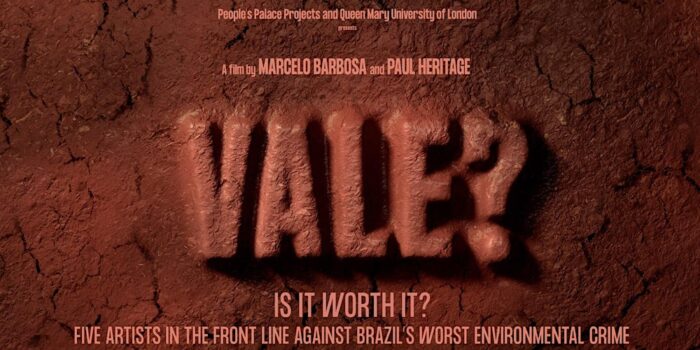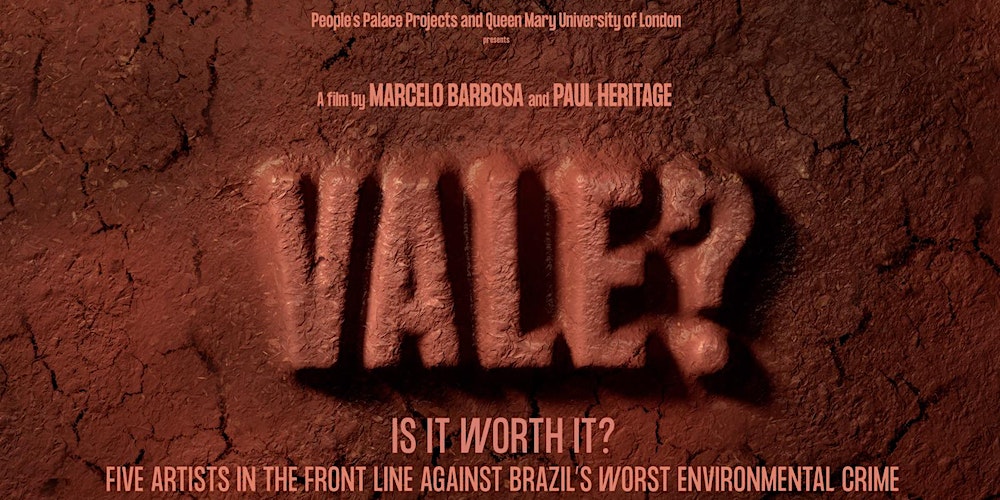Hugh Stanley reviews this documentary film about artistic responses to Brazil’s worst environmental crimes: the Brumadinho disaster and Mariana tailings dam collapses, for which megamining company, Vale, is responsible. Directed by Paul Heritage and Marcelo Barbosa, the documentary focuses on the impact of the collapse on the artistic and cultural heritage of a rich mining region in Brazil and asks: Is it worth it? The film was shown at Queen Mary University on 26 April.
When the tailings dam of the Córrego do Feijão iron ore mine failed, its toxic contents poured down the hill into the town of Brumadinho with a deadly force capable of wiping out everything in its path and killing 270 people in a terrifyingly short space of time. This was the second such dam failure to hit the state of Minas Gerais in under five years. Connecting both disasters was Vale, the vast multinational Brazilian mining company whose presence can be felt throughout political, cultural, and industrial life in Brazil. In the case of the Brumadinho disaster, Vale owned and operated the mine and dam that lay just 8 km outside of the town. In the case of the Fundão tailings dam which collapsed near the town of Mariana in Minas Gerais in 2015, Vale held a 50 per cent stake in the mining company who owned it, Samarco.
Paul Heritage, director of People’s Palace Projects and co-director with Marcelo Barbosa of Vale? Is it worth it? was keen to point out that the intention of their film was not to litigate the actions of a negligent corporation, nor to focus on its crimes. Instead, they wanted to create a tribute to the communities affected by deadly extractive mining in Brazil’s (in)famous Quadrilátero Ferrífero, or Iron Quadrangle, and shine a spotlight on the creative resistance of a handful of artists in the region. Each of the five artists featured in the film formed part of People’s Palace Project’s ongoing collaborative research project Roots of Resilience: Mining Threats to Cultural Heritage and Climate assessing the cultural and environmental impacts of mining in Minas Gerais.
…they wanted to create a tribute to the communities affected by deadly extractive mining in Brazil’s (in)famous Quadrilátero Ferrífero, or Iron Quadrangle, and shine a spotlight on the creative resistance of a handful of artists in the region.
The mining industry plays an outsized role in the daily lives of the communities it operates in in Minas Gerais (and elsewhere in Brazil). Evidence of its activities is dotted throughout the film: rainwater running through the streets, brown with mineral effluent; the chemical smell of the extractive process hanging in the air, the constant monotony of freight lorries pounding back and forth. These rhythms, these smells, these sights, form part of the everyday – but their habitual presence is a reminder too of the constant threat of disaster.
The film travels to these communities in order to find out how they use art to represent their struggle and respond to crisis. You get the sense that mining companies treat locals as one voiceless community living on its doorstep, regarded for their labour if thought about at all. Yet little consideration is given to them as a dynamic, social, and civic group with the ability to watch and to take action.
We meet various characters: the performer and theatre-maker Lucas Fabricio, the clown Jojoba, Rei Batique the musician, a traditional band from São Sebastião, and rapper Tiago Skp – whose track “Quanto Vale”, a deliberate play on the word vale (cost or worth) and the company’s name, provides the film’s provocative title Vale? Is it worth it?
All are lucid about living in this volatile dynamic among an industry that takes so much from them but also provides precious work. If they are angry, they don’t let it be the dominant expression of their art. Instead, they bring colour, creativity, and even a determined hope to what they do; as a trumpeter in the São Sebastião band reminds the viewer, Minas Gerais is about ‘more than just minerals’. The film travels back and forth between our protagonists, pluralising their experience and giving both individual attention to each artist but also unifying them in one expressive force.
The film runs for a neat 32 minutes though its brevity carries a clear message. Here, less is definitely more. Narration or voice-over is absent, yet you’d be forgiven for only noticing after the fact: the film has its own strong narrative voice through the art and unified experiences of these artists. Credit is due to the film’s co-directors for leaving themselves out of the story like this. Yet the film only offers a snapshot. I left wanting to know where the artists are now and what has happened to their stories. There’s been mining in Brazil since time immemorial but so the same is true of art. This delightful, compassionate and curious film brings that relationship forward, makes it explicit. For as long as there is a story to tell –and there always is– it is always worth telling it through the power of art.



